-
 Bitcoin
Bitcoin $107,467.9126
1.26% -
 Ethereum
Ethereum $2,447.5288
-0.12% -
 Tether USDt
Tether USDt $1.0005
0.00% -
 XRP
XRP $2.1921
0.13% -
 BNB
BNB $647.2897
0.50% -
 Solana
Solana $144.8627
-0.37% -
 USDC
USDC $0.9996
-0.03% -
 TRON
TRON $0.2732
0.10% -
 Dogecoin
Dogecoin $0.1652
-0.18% -
 Cardano
Cardano $0.5700
-2.87% -
 Hyperliquid
Hyperliquid $37.0274
-1.81% -
 Bitcoin Cash
Bitcoin Cash $484.6957
0.19% -
 Sui
Sui $2.7354
-2.19% -
 Chainlink
Chainlink $13.1727
-1.49% -
 UNUS SED LEO
UNUS SED LEO $8.9978
-0.04% -
 Stellar
Stellar $0.2421
-2.33% -
 Avalanche
Avalanche $17.5633
-3.51% -
 Toncoin
Toncoin $2.8476
-1.94% -
 Shiba Inu
Shiba Inu $0.0...01166
-0.56% -
 Litecoin
Litecoin $85.1071
0.09% -
 Hedera
Hedera $0.1502
-2.96% -
 Monero
Monero $310.2774
-1.64% -
 Dai
Dai $0.9999
-0.01% -
 Polkadot
Polkadot $3.3584
-1.88% -
 Ethena USDe
Ethena USDe $1.0003
-0.04% -
 Bitget Token
Bitget Token $4.4443
2.90% -
 Pi
Pi $0.6242
14.04% -
 Uniswap
Uniswap $6.9774
-2.86% -
 Pepe
Pepe $0.0...09535
-5.05% -
 Aave
Aave $256.7574
-3.35%
How to avoid being charged a high spread when buying Dogecoin?
To minimize Dogecoin trading costs, choose reputable exchanges with high liquidity, use limit orders, and trade during low volatility periods.
Mar 27, 2025 at 11:07 am
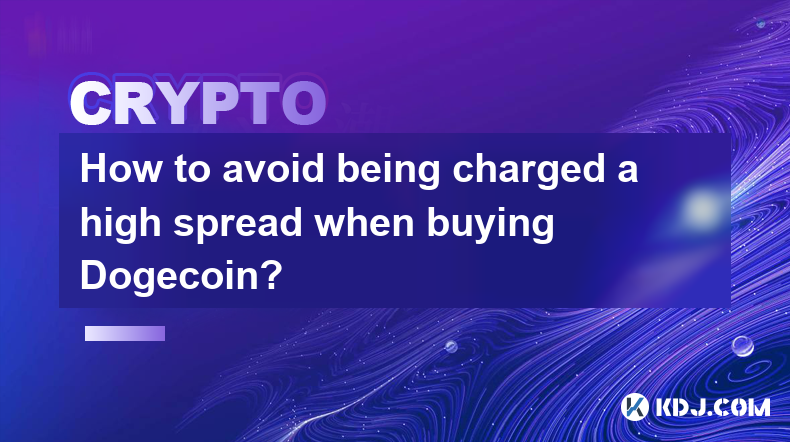
Understanding Dogecoin Spreads
The spread, in the context of cryptocurrency trading, is the difference between the best bid and the best ask price for Dogecoin (DOGE). A high spread means you'll pay more to buy DOGE than its actual market value, and receive less when selling. This difference is profit for the exchange. Several factors influence the spread, including trading volume, liquidity, and the exchange itself. Minimizing these costs is crucial for maximizing your returns.
Choosing the Right Exchange
The exchange you select plays a significant role in determining the spread you encounter. Large, reputable exchanges generally offer tighter spreads due to their high trading volume and liquidity. Conversely, smaller, less liquid exchanges may have wider spreads, making them less favorable for buying DOGE. Researching and comparing various exchanges before trading is essential. Consider factors beyond just the spread, like security measures and fees.
Timing Your Trades
Market conditions directly impact spreads. High volatility often leads to wider spreads as the market fluctuates rapidly, creating uncertainty for market makers. Conversely, periods of low volatility usually result in tighter spreads. Monitoring market conditions and trading during periods of relative calm can help you minimize spread costs. News events and announcements can also significantly influence volatility and, subsequently, spreads.
Understanding Order Types
Different order types can influence the spread you experience. A market order, which executes immediately at the best available price, may result in a wider spread, especially during volatile periods. Conversely, a limit order, which only executes when DOGE reaches your specified price, allows you to potentially avoid paying a high spread by waiting for a more favorable price. However, there's a risk your order may not fill if the price doesn't reach your limit.
Increasing Your Trading Volume
While not always feasible, increasing your trading volume can potentially lead to better spreads. High-volume traders often negotiate better rates with exchanges due to their significant contribution to liquidity. This is because exchanges benefit from high trading activity. However, this strategy is not suitable for all investors, particularly those with limited capital.
Using Limit Orders Effectively
Employing limit orders strategically can be a powerful tool to avoid high spreads. By setting a limit price slightly below the current ask price, you increase your chances of securing DOGE at a more favorable rate. However, be aware that your order might not be filled if the price doesn't reach your specified limit. Patience and careful price monitoring are key when using limit orders.
Comparing Spreads Across Exchanges
Before committing to a purchase, it's crucial to compare spreads across multiple exchanges. Many websites and tools provide real-time spread data for various cryptocurrencies, including DOGE. This allows you to identify exchanges offering the tightest spreads at the time of your trade. This comparison should be a routine part of your trading strategy.
Avoiding Less Reputable Exchanges
Sticking to well-established and regulated exchanges is paramount. Unregulated or lesser-known exchanges often have higher spreads and increased risks associated with security and scams. Prioritize exchanges with a proven track record, robust security measures, and transparent fee structures. This helps to mitigate risks beyond just the spread.
Utilizing Trading Bots (With Caution)
Automated trading bots can potentially help in identifying favorable trading opportunities and executing trades at optimal times, potentially minimizing spreads. However, using bots requires a significant understanding of algorithmic trading and carries inherent risks. It's crucial to thoroughly research and understand any bot before using it. Never use a bot without understanding its functionality and risks.
Leveraging Market Depth Information
Market depth charts provide valuable insights into the available buy and sell orders at different price levels. Understanding market depth allows you to assess liquidity and anticipate potential price movements, which can help you time your trades to minimize spreads. Learning to interpret these charts is a crucial skill for advanced traders.
Understanding Market Maker Activities
Market makers play a significant role in setting spreads. Their actions can influence the bid-ask spread, especially during periods of low liquidity. Understanding how market makers operate can help you anticipate potential spread fluctuations and adjust your trading strategy accordingly. This requires a deeper understanding of market dynamics.
The Role of Liquidity in Spread
Liquidity, or the ease with which an asset can be bought or sold, directly affects spreads. Higher liquidity typically results in tighter spreads, while low liquidity leads to wider spreads. Choosing exchanges with high trading volume and deep order books can help mitigate the impact of low liquidity on spreads.
Impact of Fees Beyond the Spread
While the spread is a significant cost, remember to account for other fees charged by the exchange. These may include trading fees, withdrawal fees, and deposit fees. Comparing the total cost, including the spread and other fees, is essential for selecting the most cost-effective exchange.
Frequently Asked Questions
Q: What is a spread in cryptocurrency trading?
A: The spread is the difference between the highest price a buyer is willing to pay (bid) and the lowest price a seller is willing to accept (ask) for a cryptocurrency like Dogecoin. A wider spread means a higher cost for you.
Q: How can I find exchanges with low Dogecoin spreads?
A: Compare spreads across multiple reputable exchanges using real-time data from websites or tools that track cryptocurrency market data. Look for exchanges with high trading volume.
Q: Are there any risks associated with trying to minimize spreads?
A: Yes, using limit orders, for example, carries the risk that your order might not be filled if the price doesn't reach your limit. Also, focusing solely on minimizing spreads can distract from other important aspects of risk management.
Q: What's the best way to time my Dogecoin trades to get the best spread?
A: Trade during periods of low volatility and avoid times of significant news or events that could cause price swings and wider spreads. Monitor market depth for liquidity indicators.
Q: Do all exchanges have the same spreads for Dogecoin?
A: No, spreads vary significantly across exchanges based on factors like liquidity, trading volume, and the exchange's own pricing mechanisms. Always compare before trading.
Disclaimer:info@kdj.com
The information provided is not trading advice. kdj.com does not assume any responsibility for any investments made based on the information provided in this article. Cryptocurrencies are highly volatile and it is highly recommended that you invest with caution after thorough research!
If you believe that the content used on this website infringes your copyright, please contact us immediately (info@kdj.com) and we will delete it promptly.
- BNB Price Check: Can Binance Coin Reserves Fuel a Rally to $800?
- 2025-06-26 20:25:12
- PEPD, Memes, and Ethereum: A New Era of Meme Utility?
- 2025-06-26 20:25:12
- DOGE, BlockDAG, and Coin Airdrops: The New Wave of Crypto Opportunities
- 2025-06-26 18:45:12
- Neo Pepe and the Crypto Presales Popping in June 2025
- 2025-06-26 18:45:12
- Bitcoin, DeFi Tokens, and Relist Moves: What's Hot in Crypto Right Now
- 2025-06-26 18:30:11
- Binance, Bitcoin, and Altcoins: Navigating the Crypto Landscape
- 2025-06-26 19:05:12
Related knowledge
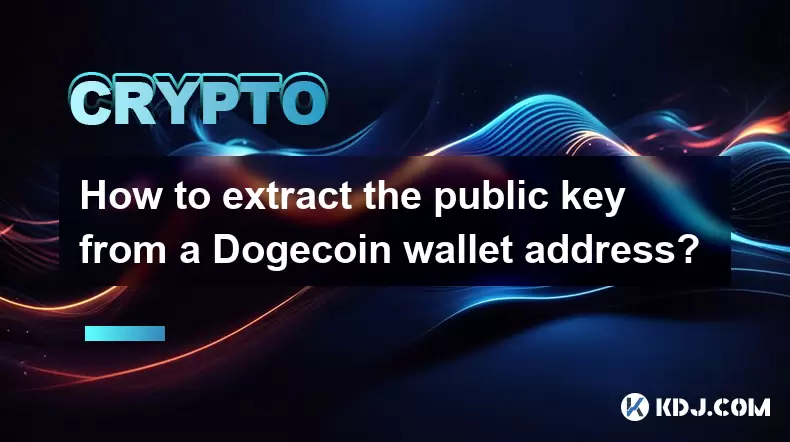
How to extract the public key from a Bitcoincoin wallet address?
Jun 16,2025 at 07:49am
Understanding the Relationship Between a Dogecoin Address and Its Public KeyIn the world of Dogecoin (DOGE), users often interact with wallet addresses but rarely see the underlying cryptographic components such as the public key or private key. A Dogecoin address is derived from the public key through a series of hashing operations. Specifically, the p...
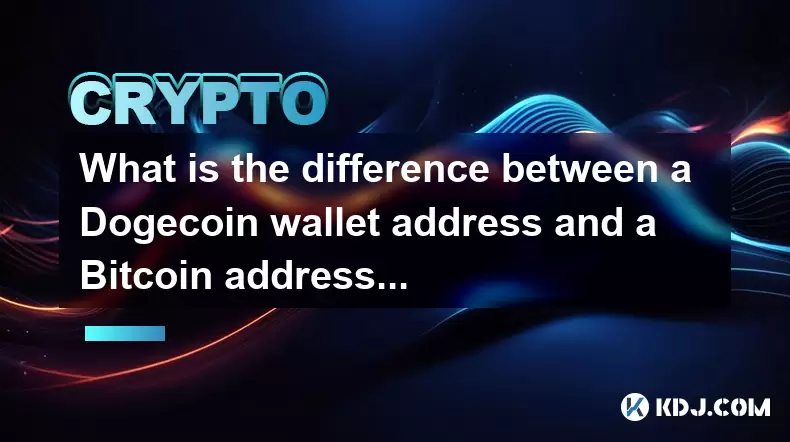
What is the difference between a Bitcoincoin wallet address and a Bitcoin address?
Jun 22,2025 at 10:28pm
Understanding the Fundamentals of Cryptocurrency AddressesIn the world of cryptocurrencies, wallet addresses serve as unique identifiers for users to send and receive digital assets. Each cryptocurrency typically has its own address format, which is derived from cryptographic algorithms and encoding methods. Both Dogecoin and Bitcoin utilize public-key ...
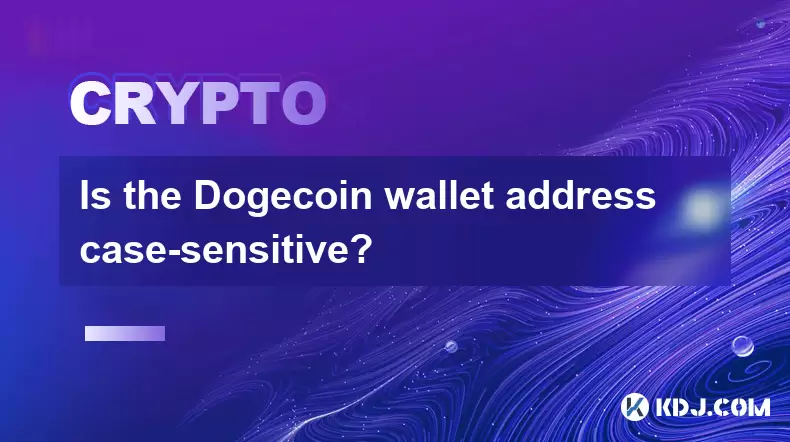
Is the Dogecoin wallet address case-sensitive?
Jun 15,2025 at 10:15pm
Understanding the Structure of a Dogecoin Wallet AddressA Dogecoin wallet address is a unique alphanumeric string used to receive and send DOGE. It typically starts with the letter 'D' and contains a combination of uppercase and lowercase letters along with numbers. The structure is based on cryptographic principles derived from public-key cryptography,...
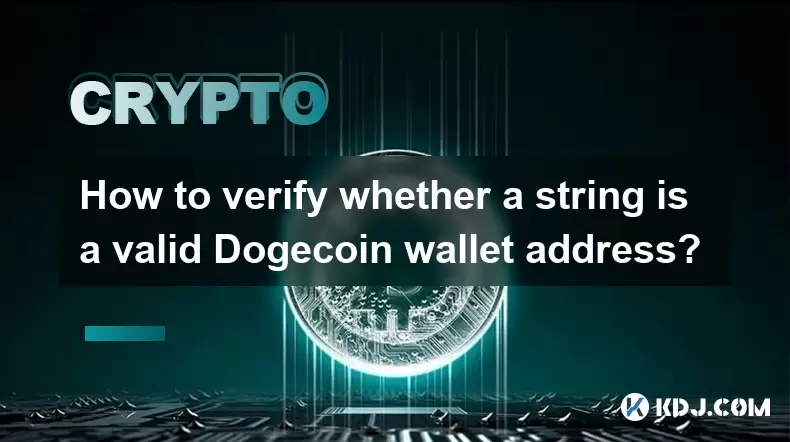
How to verify whether a string is a valid Bitcoincoin wallet address?
Jun 14,2025 at 01:57am
Understanding the Structure of a Dogecoin Wallet AddressA Dogecoin wallet address is typically composed of a combination of letters and numbers, starting with the letter 'D'. This structure follows the same format as other cryptocurrencies that use the Bitcoin protocol, but with specific prefixes unique to Dogecoin. The standard length for a Dogecoin ad...
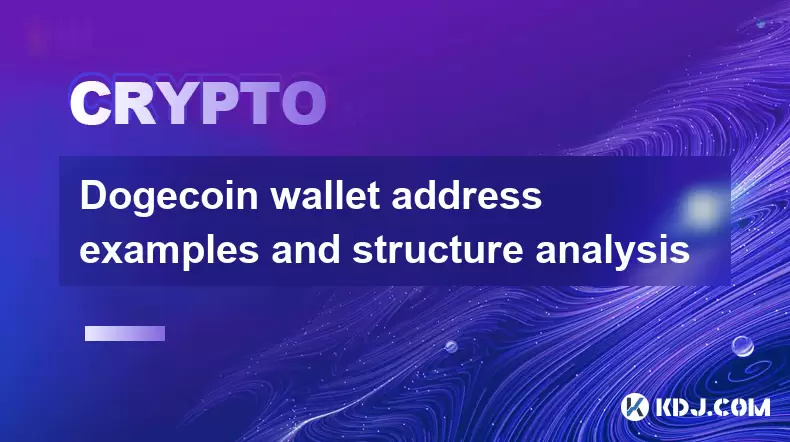
Dogecoin wallet address examples and structure analysis
Jun 13,2025 at 09:42pm
Understanding Dogecoin Wallet AddressesA Dogecoin wallet address serves as a unique identifier for receiving and sending DOGE. It functions similarly to a bank account number but is designed specifically for blockchain transactions. Each address consists of a combination of letters and numbers, typically starting with the letter 'D'. These addresses are...
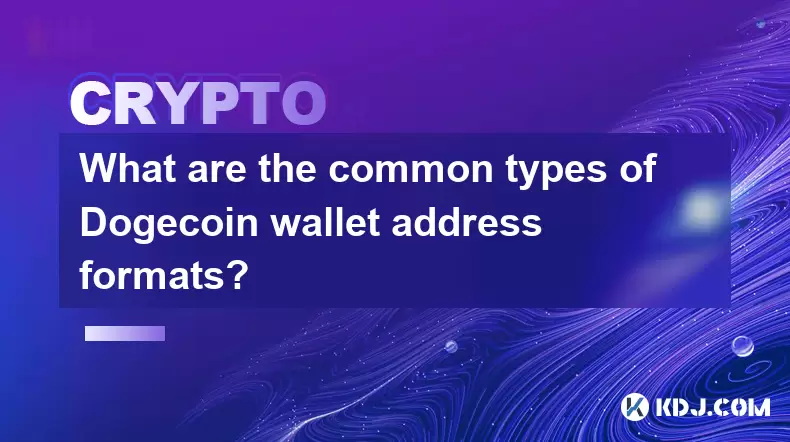
What are the common types of Dogecoin wallet address formats?
Jun 15,2025 at 08:21pm
Understanding Dogecoin Wallet AddressesDogecoin wallet addresses are alphanumeric strings used to send and receive DOGE. These addresses follow specific formats that define their structure and compatibility with different wallets and blockchain explorers. Understanding these formats is crucial for ensuring secure transactions and proper integration with...

How to extract the public key from a Bitcoincoin wallet address?
Jun 16,2025 at 07:49am
Understanding the Relationship Between a Dogecoin Address and Its Public KeyIn the world of Dogecoin (DOGE), users often interact with wallet addresses but rarely see the underlying cryptographic components such as the public key or private key. A Dogecoin address is derived from the public key through a series of hashing operations. Specifically, the p...

What is the difference between a Bitcoincoin wallet address and a Bitcoin address?
Jun 22,2025 at 10:28pm
Understanding the Fundamentals of Cryptocurrency AddressesIn the world of cryptocurrencies, wallet addresses serve as unique identifiers for users to send and receive digital assets. Each cryptocurrency typically has its own address format, which is derived from cryptographic algorithms and encoding methods. Both Dogecoin and Bitcoin utilize public-key ...

Is the Dogecoin wallet address case-sensitive?
Jun 15,2025 at 10:15pm
Understanding the Structure of a Dogecoin Wallet AddressA Dogecoin wallet address is a unique alphanumeric string used to receive and send DOGE. It typically starts with the letter 'D' and contains a combination of uppercase and lowercase letters along with numbers. The structure is based on cryptographic principles derived from public-key cryptography,...

How to verify whether a string is a valid Bitcoincoin wallet address?
Jun 14,2025 at 01:57am
Understanding the Structure of a Dogecoin Wallet AddressA Dogecoin wallet address is typically composed of a combination of letters and numbers, starting with the letter 'D'. This structure follows the same format as other cryptocurrencies that use the Bitcoin protocol, but with specific prefixes unique to Dogecoin. The standard length for a Dogecoin ad...

Dogecoin wallet address examples and structure analysis
Jun 13,2025 at 09:42pm
Understanding Dogecoin Wallet AddressesA Dogecoin wallet address serves as a unique identifier for receiving and sending DOGE. It functions similarly to a bank account number but is designed specifically for blockchain transactions. Each address consists of a combination of letters and numbers, typically starting with the letter 'D'. These addresses are...

What are the common types of Dogecoin wallet address formats?
Jun 15,2025 at 08:21pm
Understanding Dogecoin Wallet AddressesDogecoin wallet addresses are alphanumeric strings used to send and receive DOGE. These addresses follow specific formats that define their structure and compatibility with different wallets and blockchain explorers. Understanding these formats is crucial for ensuring secure transactions and proper integration with...
See all articles
























































































